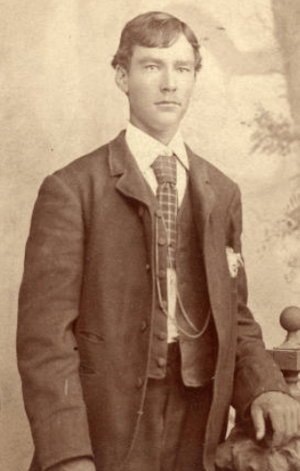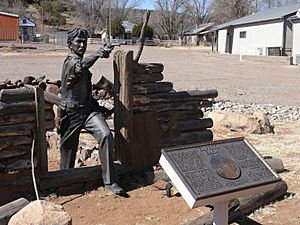Elfego Baca facts for kids
Quick facts for kids
Elfego
|
|
|---|---|

Elfego Baca in 1883
|
|
| Born | February 10, 1865 |
| Died | August 27, 1945 (aged 80) |
| Occupation | Gunfighter, sheriff, lawyer and politician |
| Political party | Republican Party |
| Family |
|
Elfego Baca (born February 10, 1865 – died August 27, 1945) was a famous lawman, lawyer, and politician in New Mexico. He lived during the exciting times of the frontier in the New Mexico Territory. Elfego Baca became known as an American folk hero because of his bravery and unique way of handling outlaws.
His main goal was to be a peace officer. He wanted "the outlaws to hear [his] steps a block away," meaning he wanted criminals to be afraid of him and his commitment to justice.
The Walt Disney Presents show even made a Western TV series about him called The Nine Lives of Elfego Baca. This series was later turned into a movie, Elfego Baca: Six Gun Law.
Contents
Early Life and Becoming a Deputy
Elfego Baca was born in 1865 in Socorro, New Mexico. His parents were Francisco and Juana Maria Baca. When he was young, his family moved to Topeka, Kansas.
After his mother passed away in 1880, Elfego and his father returned to Belen, New Mexico. There, his father became a marshal, which is a type of law enforcement officer.
In 1884, when Elfego was just 19 years old, he decided to become a deputy sheriff. He got some guns and started working in Socorro County, New Mexico. It's not fully clear if he bought a badge or was officially appointed, but he was ready to bring law and order.
The Famous Frisco Shootout
One of Elfego Baca's most famous stories happened in a place called Frisco. He was a deputy sheriff and tried to arrest a cowboy named Charlie McCarty. Elfego took Charlie's gun, but other cowboys tried to stop him. Elfego had to defend himself.
During the fight, one cowboy's horse was shot and fell on him, causing his death. Elfego also shot another cowboy in the knee. A local judge then tried to free McCarty and wanted to question Elfego. Elfego refused to leave the adobe jail building where he was.
A rancher named Bert Hearne tried to force Elfego out of the jail. Shots were fired from inside the jail, and Hearne was hit and died. This led to a long standoff with many cowboys.
A Standoff Against Many
Villagers said about 40 cowboys gathered, but Elfego Baca later claimed there were at least 80. These cowboys fired thousands of shots into the small adobe building where Elfego was hiding. It's said they fired over 4,000 bullets!
Amazingly, not a single bullet hit Elfego Baca. People believe the floor of the building was a bit lower than the ground outside. This might have helped him stay safe from the bullets.
After about 33 hours, the battle finally ended. A man named Francisquito Naranjo convinced Elfego to give up. In May 1885, Elfego was charged with murder for the deaths that occurred.
Baca's Acquittal
In August 1885, Elfego Baca went to trial. He was found not guilty. A key piece of evidence was the door of the adobe house where he had been. It had more than 400 bullet holes in it, showing how much he had been shot at. This entire event became known as the Frisco shootout.
A Life of Law and Order
After the Frisco shootout, Elfego Baca officially became the sheriff of Socorro County. He was very determined to catch lawbreakers. Instead of sending his deputies to chase wanted men, he sent each accused person a letter.
His letters were direct: "I have a warrant here for your arrest. Please come in by March 15 and give yourself up. If you don’t, I’ll know you intend to resist arrest, and I will feel justified in shooting you on sight when I come after you." Because of his reputation, most of the offenders turned themselves in without a fight.
From Marshal to Lawyer
In 1888, Elfego Baca became a U.S. Marshal. He worked in this role for two years. After that, he decided to study law.
In December 1894, he passed his exams and became a lawyer. He even worked with a judge's law firm for a short time. Later, he practiced law in El Paso between 1902 and 1904.
Elfego Baca's Political Career
Elfego Baca held many important public jobs. He was a county clerk, the mayor of Socorro County, and even a school superintendent. He also served as a district attorney for Socorro and Sierra counties.
Historian Leon Metz, who wrote about Elfego, said that "most reports say he was the best peace officer Socorro ever had." This shows how respected he was in his community.
Working in Politics and for Mexico
From 1913 to 1916, Elfego Baca was a special representative for the Mexican government during the Mexican Revolution. He worked with Victoriano Huerta's government.
In 1915, Elfego was accused of helping a Mexican general escape from jail. He was successfully defended by a famous lawyer named Octaviano Ambrosio Larrazolo. This event made Elfego even more well-known in the Southwest.
When New Mexico became a state in 1912, Elfego tried to run for Congress. He didn't win, but he remained an important political figure. He was good at getting people from the Hispanic community to vote. He also worked as a private detective and even as a bouncer in a casino in Mexico.
Elfego Baca worked closely with Senator Bronson Cutting of New Mexico. He wrote articles in Spanish praising the Senator's work for local Hispanic people. Even though his health was declining, Elfego considered running for governor. He was a very active and influential person throughout his life.
Legends About Elfego Baca
Many stories and legends grew around Elfego Baca. One popular tale says that he once took a pistol from the famous Mexican revolutionary Pancho Villa. The story goes that Villa was so angry he put a huge reward of $30,000 on Elfego's head!
Another often-told story shows Elfego's cleverness as a lawyer. While practicing law in Albuquerque, he supposedly got a telegram from a client in El Paso who had been charged with murder. The client's message was, "Need you at once. Have just been charged with murder." Elfego is said to have quickly replied with his own telegram: "Leaving at once with three eyewitnesses."
Elfego Baca in Popular Media
In the late 1950s, Walt Disney Studios helped make Elfego Baca a popular hero in the United States. They created a TV miniseries, comic books, a movie, and other products about him. Disney wanted to show him as a general Western hero, like a "New Mexican Davy Crockett."
The Nine Lives of Elfego Baca TV Series
Most of the Disney series was filmed in New Mexico. Starting in October 1958, Walt Disney Studios released a 10-part TV series called The Nine Lives of Elfego Baca. Robert Loggia played Elfego Baca in the show. It was part of the Walt Disney Presents TV series.
Disney tried hard to show the famous shootout as accurately as possible. The theme song for the show had a catchy line: "And the legend was that / Like el gato, 'the cat' / Nine lives had Elfego Baca."
Movies and Other Appearances
Episodes from the TV series were later put together to make a movie in 1962 called Elfego Baca: Six Gun Law. In 1966, another version of the episodes was released as a film, also titled Elfego Baca: Six Gun Law. This movie was directed by Christian Nyby and again starred Robert Loggia. It was later shown on American television as Elfego Baca: Attorney at Law.
Elfego Baca has also appeared in other stories. In a comic book series by Dynamite Entertainment featuring The Lone Ranger and Green Hornet, Elfego has a small role. He is shown at a friendly meeting with other Western heroes like Bat Masterson, Buffalo Bill, Wyatt Earp, and Annie Oakley.
New Mexico author Rudolfo Anaya wrote four mystery novels that feature Elfego's grandson, Sonny Baca. Sonny lives in Albuquerque and carries what is believed to be Elfego's old revolver. These modern stories mix mystery with magic.
See also
- Baca Family of New Mexico
 In Spanish: Elfego Baca para niños
In Spanish: Elfego Baca para niños
Images for kids



